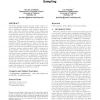Free Online Productivity Tools
i2Speak
i2Symbol
i2OCR
iTex2Img
iWeb2Print
iWeb2Shot
i2Type
iPdf2Split
iPdf2Merge
i2Bopomofo
i2Arabic
i2Style
i2Image
i2PDF
iLatex2Rtf
Sci2ools
RECOMB
2004
Springer
2004
Springer
Multiple organism gene finding by collapsed gibbs sampling
The Gibbs sampling method has been widely used for sequence analysis after it was successfully applied to the problem of identifying regulatory motif sequences upstream of genes. Since then numerous variants of the original idea have emerged, however in all cases the application has been to finding short motifs in collections of short sequences (typically less than 100 nucleotides long). In this paper we introduce a Gibbs sampling approach for identifying genes in multiple large genomic sequences up to hundreds of kilobases long. This approach leverages the evolutionary relationships between the sequences to improve the gene predictions, without explicitly aligning the sequences. We have applied our method to the analysis of genomic sequence from
Computational Biology | Gibbs Sampling Approach | Gibbs Sampling Method | RECOMB 2004 | Regulatory Motif Sequences |
| Added | 03 Dec 2009 |
| Updated | 03 Dec 2009 |
| Type | Conference |
| Year | 2004 |
| Where | RECOMB |
| Authors | Sourav Chatterji, Lior Pachter |
Comments (0)

